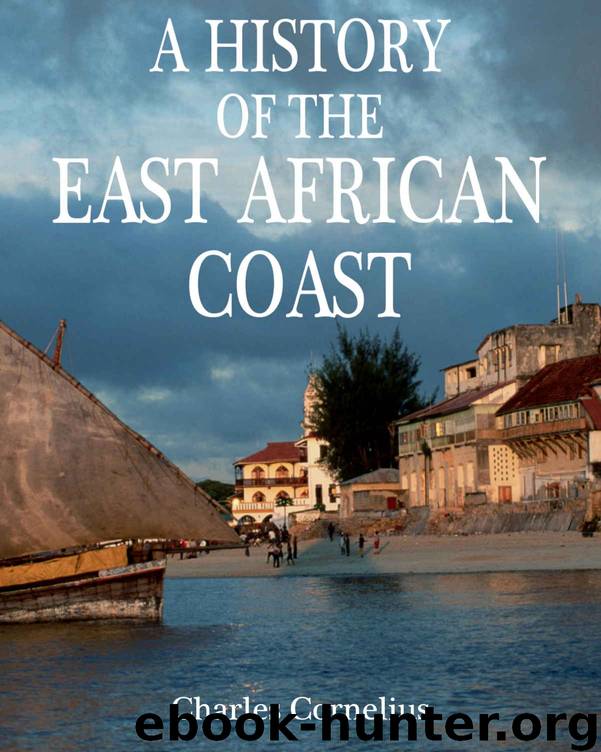A History of the East African Coast by Charles Cornelius

Author:Charles Cornelius [Cornelius, Charles]
Language: eng
Format: epub
Publisher: UNKNOWN
Published: 2013-09-27T04:00:00+00:00
The Decline of Portuguese Control
If the Swahili, Turks, Zimba and Segeju weren't already enough of a threat, new rivals to the Portuguese began emerging at the end of the sixteenth century. In 1591, three English ships under the command of the Elizabethan privateer, Sir James Lancaster, were sent to investigate opportunities for breaking the Portuguese monopoly on trade in the Indian Ocean. The merchants of London, whose confidence exploiting commerce in new parts of the world was fast growing as a result of ventures in North America, were starting to view India as the next target. The Portuguese, still licking wounds inflicted by the Turks, certainly did not relish the prospect of another rival and warned the Swahili that this new breed of whites were, in fact, cannibals. The Swahili kept their distance, but Lancaster's reports of the riches of Zanzibar and India encouraged the formation, nine years later, of the East India Company, a commercial organisation that would later become the dominant military and political force in the sub-continent. Soon after, the French formed a similar trading company in the region, as did the Dutch who later gave herself control of access to the Indian Ocean from Europe by establishing a territorial colony at the Cape of Good Hope.
In the north, Portuguese control in Arabia was gradually being eroded by the Omani and Persians, powers at the fringes of the Turkish empire which would grow as Ottoman control of the region began to diminish during the seventeenth century. In 1622, the Portuguese suffered a psychologically devastating defeat at the hands of the Persians which cost them control of Ormuz, the port that controlled access to the Persian Gulf. In 1643, the Portuguese fort at Sohar fell to Oman under her ruler, Nasir bin Murshid. The seventeenth century therefore saw Portugal become just one of many players in the commercial and political world of the Indian Ocean.
As if the complications of these new rivals were not enough, the Portuguese even managed to develop strained relations with the usually loyal King of Malindi. Things had become so bad that in 1614, the king sailed to Goa to complain of Portuguese arrogance. On his return he was murdered by Nyika tribesmen employed by the Captain of Malindi. As a means of ensuring that the king's eight year old son, Yusuf bin Hasan, would turn out to be a more reliable successor, the Portuguese sent him to Goa to receive a western upbringing. Converting to Catholicism, Yusuf adopted the name Don Geronimo Cinghallia and married a Portuguese woman, returning to Mombasa in 1630.
The Portuguese were confident that this Christian Swahili would prove to be a reliable puppet. Then, on 15th August 1631, when many of the Portuguese merchants, soldiers, priests and administrators were gathered in the town for the Day of the Feast of the Assumption, Don Geronimo paid a visit to the Portuguese commandant of Fort Jesus. A Portuguese account describes their meeting:
“The king sent to the Commandant of the fortress, Pedro Leitao de Gamboa, to say that he wished to pay him a visit.
Download
This site does not store any files on its server. We only index and link to content provided by other sites. Please contact the content providers to delete copyright contents if any and email us, we'll remove relevant links or contents immediately.
| Africa | Americas |
| Arctic & Antarctica | Asia |
| Australia & Oceania | Europe |
| Middle East | Russia |
| United States | World |
| Ancient Civilizations | Military |
| Historical Study & Educational Resources |
Pirates of Somalia by Jay Bahadur(1115)
Out of Africa by Isak Dinesen(659)
Dreams in a Time of War: A Childhood Memoir by Ngugi Wa Thiong'o(412)
A History of the East African Coast by Charles Cornelius(411)
Swahili Port Cities by prita meier(382)
I Am Evelyn Amony by Evelyn Amony(380)
Aagaard's African Adventures by Finn Aagaard(369)
Where Soldiers Fear to Tread by John Burnett(360)
Mugabe: Power, Plunder, and the Struggle for Zimbabwe's Future by Martin Meredith(314)
The Addis Ababa Massacre by Campbell Ian;(304)
Inside the Hotel Rwanda by Edouard Kayihura(303)
Mau Mau Rebellion by Nicholas van der Bijl(300)
Terrorism, Betrayal, and Resilience by Prudence Bushnell(280)
The First Victory by Andrew Stewart(260)
Terrorism, Betrayal, and Resilience: My Story of the 1998 U.S. Embassy Bombings by Prudence Bushnell(255)
Common People's Uganda by Yash Tandon(232)
Air War East Africa 1940-41: The RAF Versus the Italian Air Force by Jon Sutherland & Diane Canwell(220)
UNDERSTANDING CONTEMPORARY ETHIOPIA by GÉRARD PRUNIER; ÉLOI FICQUET(203)
